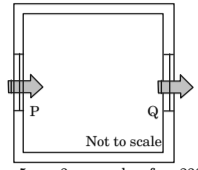Architecture and Planning Miscellaneous-topic
- As per the Urban and Regional Development Plan Formulation and Implementation (URDPFI) guidelines, the planperiod considered in a ‘Perspective plan’ is
-
View Hint View Answer Discuss in Forum
Perspective planning is a blueprint regarding the objectives and targets of long run growth. The perspective plan is not just a plan, rather to attain certain objectives and targets; the perspective plan is divided into certain smaller plans. A Perspective Plan is a long term (20-25 years) written document supported by necessary maps and diagrams providing the state government the goal s, pol i ci es, st r at egi es and general programmes of the urban local authority regarding spatio-economic development of the settlement under its governance.

Correct Option: C
Perspective planning is a blueprint regarding the objectives and targets of long run growth. The perspective plan is not just a plan, rather to attain certain objectives and targets; the perspective plan is divided into certain smaller plans. A Perspective Plan is a long term (20-25 years) written document supported by necessary maps and diagrams providing the state government the goal s, pol i ci es, st r at egi es and general programmes of the urban local authority regarding spatio-economic development of the settlement under its governance.

- The Hall of Nations, New Delhi, was designed by
-
View Hint View Answer Discuss in Forum
The Per manent Exhibition Complex is designed to form the focus of 130 acres of Exhibition ground designed by Raj Rewal in New Delhi.
Correct Option: B
The Per manent Exhibition Complex is designed to form the focus of 130 acres of Exhibition ground designed by Raj Rewal in New Delhi.
- As per the National Building Code of India 2016, the minimum turning radius (in metres) required for fire tender movement is
-
View Hint View Answer Discuss in Forum
For buildings identified in Building Bye-Laws 7.1 the following provisions of means of access shall be applicable.
(a) The width of the main street on which the building abuts shall not be less than 12.0 m.
(b) If there are any bends or curves in the approach road, sufficient width shall be permitted at the curve to enable the fire tenders to turn, the turning circle shall be at least of 9.0 m. radius.Correct Option: C
For buildings identified in Building Bye-Laws 7.1 the following provisions of means of access shall be applicable.
(a) The width of the main street on which the building abuts shall not be less than 12.0 m.
(b) If there are any bends or curves in the approach road, sufficient width shall be permitted at the curve to enable the fire tenders to turn, the turning circle shall be at least of 9.0 m. radius.
- Associat e the symbols in Group I wit h their meanings in Group II types in Group – II
Group I Group II 
1. Hearing impaired 
2 Emergency lamp 
3. Electrical and Electronic waste disposal 
4. Biohazard 5. Speech impaired
-
View Hint View Answer Discuss in Forum
NA
Correct Option: D
NA
- An isolated enclosure shown in the Figure has inlet P and outlet Q of 2 sqm each, on the opposite walls. The outdoor wind speed is 5 m/sec. If the coefficient of effectiveness is 0.6, the rate of natural ventilation in the enclosure due to wind action is _________ cum/hr.

-
View Hint View Answer Discuss in Forum
21600 to 21600
Volume of air getting extracted from the Inlet/OutletArea of Area of Inlet .(V = A × S) Outlet × Speed
Here, The area of inlet and outlet = 2 sq.m, and wind speed = 5m/sec.
Thus, volume of air getting extracted from inlet P per second = 2m² × 5m/sec = 10m³/sec.
As we know, 1 hr. = 60 min = 3600 sec.
Volume of air getting extracted inside from inlet P per hour = 10m³ × 3600/hr. = 36000 m³/hr.
If the co-efficient of effect iveness is 1 then, amount of air getting extracted frominlet = amount of air extracted from outlet.
Here, co-efficient of effectiveness = 0.6
Thus, rate of natural ventilation per hour = 0.6 × amount of air coming inside from inlet P per hour = 0.6 × 36,000 = 21,600 m³/hour.Correct Option: A
21600 to 21600
Volume of air getting extracted from the Inlet/OutletArea of Area of Inlet .(V = A × S) Outlet × Speed
Here, The area of inlet and outlet = 2 sq.m, and wind speed = 5m/sec.
Thus, volume of air getting extracted from inlet P per second = 2m² × 5m/sec = 10m³/sec.
As we know, 1 hr. = 60 min = 3600 sec.
Volume of air getting extracted inside from inlet P per hour = 10m³ × 3600/hr. = 36000 m³/hr.
If the co-efficient of effect iveness is 1 then, amount of air getting extracted frominlet = amount of air extracted from outlet.
Here, co-efficient of effectiveness = 0.6
Thus, rate of natural ventilation per hour = 0.6 × amount of air coming inside from inlet P per hour = 0.6 × 36,000 = 21,600 m³/hour.

